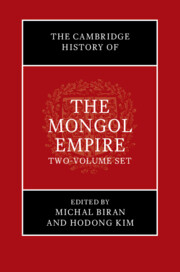Book contents
- The Cambridge History of the Mongol Empire
- The Cambridge History of the Mongol Empire
- Copyright page
- Dedication
- Contents
- Figures in Volume I
- Figures in Volume II
- Maps in Volume I
- Maps in Volume II
- Tables in Volume I
- Contributors to Volume I
- Contributors to Volume II
- Acknowledgments
- Notes on Dates and Transliterations
- Abbreviations
- Volume I
- Volume II
- Volume II Part 1 Literary Sources
- 1 Persian Sources
- 2 Chinese Sources
- 3 Mongolian Sources
- 4 Arabic Sources
- 5 Rus′ian-Language Sources
- 6 Western European Sources
- 7 Armenian Sources
- 8 Georgian Sources
- 9 Turkic and Chaghatay Sources
- 10 Tibetan Sources
- 11 Korean Sources
- 12 Syriac Sources
- 13 Uighur Sources
- 14 Greek Sources
- 15 Tangut Sources
- 16 Hebrew Sources
- Volume II Part 2 Archaeological and Visual Sources
- Index to Volume I
- Index to Volume II
- References
9 - Turkic and Chaghatay Sources
from Volume II Part 1 - Literary Sources
Published online by Cambridge University Press: 01 January 2024
- The Cambridge History of the Mongol Empire
- The Cambridge History of the Mongol Empire
- Copyright page
- Dedication
- Contents
- Figures in Volume I
- Figures in Volume II
- Maps in Volume I
- Maps in Volume II
- Tables in Volume I
- Contributors to Volume I
- Contributors to Volume II
- Acknowledgments
- Notes on Dates and Transliterations
- Abbreviations
- Volume I
- Volume II
- Volume II Part 1 Literary Sources
- 1 Persian Sources
- 2 Chinese Sources
- 3 Mongolian Sources
- 4 Arabic Sources
- 5 Rus′ian-Language Sources
- 6 Western European Sources
- 7 Armenian Sources
- 8 Georgian Sources
- 9 Turkic and Chaghatay Sources
- 10 Tibetan Sources
- 11 Korean Sources
- 12 Syriac Sources
- 13 Uighur Sources
- 14 Greek Sources
- 15 Tangut Sources
- 16 Hebrew Sources
- Volume II Part 2 Archaeological and Visual Sources
- Index to Volume I
- Index to Volume II
- References
Summary
This chapter surveys the extant examples of Islamic literature in Turkic produced in the western parts of the Mongol-ruled world in the thirteenth and fourteenth centuries, as evidence for the process of Islamization and cultural assimilation occurring under Mongol rule. A brief note on the production, in the Mongol era, of most of the surviving manuscripts of pre-Mongol Islamic Turkic works is followed by discussion of the questions of authorship, content, and patronage for the major Turkic literary products from the ulus of Jochi – the Muʿīn al-murīd, the Khusraw va Shīrīn of Quṭb, the Maḥabbat-nāma of Khwārazmī, and the Nahj al-farādīs of Maḥmūd b. ʻAlī – and for those from the Chaghadaid realm – Rabghūzī’s Qiṣaṣ al-anbiyā and the work of Isḥāq Khwāja b. Ismāʻīl Ata.
Keywords
- Type
- Chapter
- Information
- The Cambridge History of the Mongol Empire , pp. 1149 - 1164Publisher: Cambridge University PressPrint publication year: 2023

